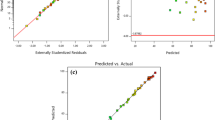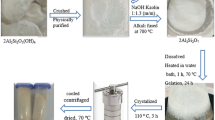Abstract
A simple one-step synthetic approach using rice husk has been developed to prepare magnetic Fe3O4-loaded porous carbons composite (MRH) for removal of arsenate (As(V)). The characteristics of adsorbent were evaluated by transmission electron microscope, scanning electron microscopy, X-ray diffraction, Fourier transform infrared spectroscopy, Brunauer–Emmett–Teller analysis, and thermogravimetric analysis. On account of the combined advantages of rice husk carbons and Fe3O4 nanoparticles, the synthesized MRH composites showed excellent adsorption efficiency for aqueous As(V). The removal of As(V) by the MRH was studied as a function of contact time, initial concentration of As(V), and media pH. The adsorption kinetics of As(V) exhibited a rapid sorption dynamics by a pseudo-second-order kinetic model, implying the mechanism of chemisorption. The adsorption data of As(V) were fitted well to the Langmuir isotherm model, and the maximum uptake amount (q m ) was calculated as 4.33 mg g−1. The successive regeneration and reuse studies showed that the MRH kept the sorption efficiencies over five cycles. The obtained results demonstrate that the MRH can be utilized as an efficient and low-cost adsorbent for removal of As(V) from aqueous solutions.








Similar content being viewed by others
References
Ai L, Jiang J (2010) Fast removal of organic dyes from aqueous solutions by AC/ferrospinel composite. Desalination 262(1–3):134–140
Bard AJ, Parsons R, Jordan J (1985) Standard potentials in aqueous solutions. Marcel Dekker, New York 162
Castro MM, Martínez-Escandell M, Molina-Sabio M, Rodríguez-Reinoso F (2010) Hydrogen adsorption on KOH activated carbons from mesophase pitch containing Si, B, Ti or Fe. Carbon 48(3):636–644
Chandra V, Park J, Chun Y, Lee JW, Hwang IC, Kim KS (2010) Water-dispersible magnetite-reduced graphene oxide composites for arsenic removal. ACS Nano 4(7):3979–3986
Chang QG, Lin W, Ying WC (2010) Preparation of iron-impregnated granular activated carbon for arsenic removal from drinking water. J Hazard Mater 184(1–3):515–522
Chen W, Parette R, Zou J, Cannon FS, Dempsey BA (2007) Arsenic removal by iron modified activated carbon. Water Res 41(9):1851–1858
Choi H, Al-Abed SR, Agarwal S, Dionysiou DD (2008) Synthesis of reactive nano-Fe/Pd bimetallic system-impregnated activated carbon for the simultaneous adsorption and dechlorination of PCBs. Chem Mater 20(11):3649–3655
Dang SV, Kawasaki J, Abella LC, Auresenia J, Habaki H, Gaspillo PD, Kosuge H, Doan HT (2009) Removal of arsenic from simulated groundwater by adsorption using iron-modified rice husk carbon. J Water Environ Technol 7(2):43–56
Do MH, Phan NH, Nguyen TD, Pham TTS, Nguyen VK, Vu TTT, Nguyen TKP (2011) Activated carbon/Fe3O4 nanoparticle composite: fabrication, methyl orange removal and regeneration by hydrogen peroxide. Chemosphere 85(8):1269–1276
Fang M, Yang L, Chen G, Shi Z, Luo Z, Cen K (2004) Experimental study on rice husk combustion in a circulating fluidized bed. Fuel Process Technol 85(11):1273–1282
Foo KY, Hameed BH (2009) Utilization of biodiesel waste as a renewable resource for activated carbon: application to environmental problems. Renew Sustain Energy Rev 13(9):2495–2504
Freundlich HMF (1906) Über die adsorption in lösungen. Z Phys Chem 57(A):385–470
Ho YS (2006) Second-order kinetic model for the sorption of cadmium onto tree fern: a comparison of linear and non-linear methods. Water Res 40(1):119–125
Ho YS, McKay G (1999) Pseudo-second order model for sorption processes. Process Biochem 34(5):451–465
Jia YF, Xu L, Wang X, Demopoulos GP (2007) Infrared spectroscopic and X-ray diffraction characterization of the nature of adsorbed arsenate on ferrihydrite. Geochim Cosmochim Acta 71(7):1643–1654
Kakavandi B, Jafari AJ, Kalantary RR, Nasseri S, Ameri A, Esrafily A (2013) Synthesis and properties of Fe3O4-activated carbon magnetic nanoparticles for removal of aniline from aqueous solution: equilibrium, kinetic and thermodynamic studies. Iranian J Environ Health Sci Eng 10(1):10–19
Kamari A, Wan Ngah WS, Chong MY, Cheah ML (2009) Sorption of acid dyes onto GLA and H2SO4 cross-linked chitosan beads. Desalination 249(3):1180–1189
Kannan K, Sundaram MM (2001) Kinetics and mechanism of removal of methylene blue by adsorption on various carbons-a comparative study. Dyes Pigm 51(1):25–40
Lagergren S (1898) Zur théorie der sogenannten adsorption gelöster stoffe. Kungliga Svenska Vetenskapsakademiens. Handlingar 24(4):1–39
Langmuir I (1918) The adsorption of gases on plane surfaces of glass, mica and platinum. J Am Chem Soc 40(9):1361–1403
Liou TH (2004) Evolution of chemistry and morphology during the carbonization and combustion of rice husk. Carbon 42(4):785–794
Liou TH, Wu SJ (2009) Characteristics of microporous/mesoporous carbons prepared from rice husk under base- and acid-treated conditions. J Hazard Mater 171(1–3):693–703
Liu ZG, Zhang FS (2010) Nano-zero valent iron contained porous carbons developed from waste biomass for the adsorption and dechlorination of PCBs. Bioresour Technol 101(7):2562–2564
Liu ZG, Zhang FS, Sasai R (2010) Arsenate removal from water using Fe3O4-loaded activated carbon prepared from waste biomass. Chem Eng J 160(1):57–62
Moreno-Castilla C, Carrasco-Marnn F, Mueden A (1997) The creation of acid carbon surfaces by treatment with (NH4)2S2O8. Carbon 35(10–11):1619–1626
Namduri H, Nasrazadani S (2008) Quantitative analysis of iron oxides using Fourier transform infrared spectrophotometry. Corros Sci 50(9):2493–2497
Oliveira LCA, Pereira E, Guimarae IR, Vallone A, Pereira M, Mesquita JP, Sapag K (2009) Preparation of activated carbons from coffee husks utilizing FeCl3 and ZnCl2 as activating agents. J Hazard Mater 165(1–3):87–94
Patel M, Karera A, Prasanna P (1987) Effect of thermal and chemical treatments on carbon and silica contents in rice husk. J Mater Sci 22(7):2457–2464
Patterson AL (1939) The Scherrer formula for X-ray particle size determination. Phys Rev 56:978–982
Pereira MFR, Soares SF, Orfao JJM, Figueiredo JL (2003) Adsorption of dyes on activated carbons: influence of surface chemical groups. Carbon 41(4):811–821
Sing KSW (1985) Reporting physisorption data for gas/solid systems with special reference to the determination of surface area and porosity (Recommendations 1984). Pure Appl Chem 57(4):603–619
Stuart B, George WO, Mcintyre PS (1996) Modern infrared spectroscopy. John Wiley and Sons, Chichester
Sun HM, Cao LY, Lu LH (2011) Magnetite/reduced graphene oxide nanocomposites: one step solvothermal synthesis and use as a novel platform for removal of dye pollutants. Nano Res 4(6):550–562
Weber WJ, Morris JC (1963) Kinetics of adsorption on carbon from solution. J Sanit Eng Div 89(2):31–60
Yang TZ, Shen CM, Li ZA, Zhang HR, Xiao CW, Chen ST, Xu ZC, Shi DX, Li JQ, Gao HJ (2005) Highly ordered self-assembly with large area of Fe3O4 nanoparticles and the magnetic properties. J Phys Chem B 109(49):23233–23236
Yang N, Zhu S, Zhang D, Xu S (2008) Synthesis and properties of magnetic Fe3O4-activated carbon nanocomposite particles for dye removal. Mater Lett 62(4–5):645–647
Yean S, Cong L, Yavuz CT, Mayo JT, Yu WW, Kan AT, Colvin VL, Tomson MB (2005) Effect of magnetite particle size on adsorption and desorption of arsenite and arsenate. J Mater Res 20(12):3255–3264
Yun CH, Park YH, Park CR (2001) Effects of pre-carbonization on porosity development of activated carbons from rice straw. Carbon 39(4):559–567
Zanzi R, Bai X, Capdevila P, Björnbom E (2001) Pyrolysis of biomass in presence of steam for preparation of activated carbon, liquid and gaseous products. In: 6th World Congress of Chemical Engineering Melbourne, Australia 23–27
Zhang FS, Itoh H (2005) Iron oxide-loaded slag for arsenic removal from aqueous system. Chemosphere 60(3):319–325
Zhang G, Qu J, Liu H, Cooper AT, Wu R (2007) CuFe2O4/activated carbon composite: a novel magnetic adsorbent for the removal of acid orange II and catalytic regeneration. Chemosphere 68(6):1058–1066
Zhang F, Li GD, Chen JS (2008) Effects of raw material texture and activation manner on surface area of porous carbons derived from biomass resources. J Colloid Interface Sci 327(1):108–114
Zhang YX, Xu SC, Luo YY, Pan SS, Ding HL, Li GH (2011) Synthesis of mesoporous carbon capsules encapsulated with magnetite nanoparticles and their application in wastewater treatment. J Mater Chem 21:3664–3671
Zhu HY, Fu YQ, Jiang R, Jiang JH, Xiao L, Zeng GM, Zhao SL, Wang Y (2011) Adsorption removal of congo red onto magnetic cellulose/Fe3O4/activated carbon composite: equilibrium, kinetic and thermodynamic studies. Chem Eng J 173(2):494–502
Acknowledgments
The authors greatly acknowledge the National Natural Science Foundation of China (No. 41301338), Hunan Provincial Natural Science Foundation of China (No. 13JJ4069), and Scientific Research Staring Foundation for the introduced talents of Hunan Agricultural University (No. 12YJ12).
Author information
Authors and Affiliations
Corresponding author
Electronic supplementary material
Below is the link to the electronic supplementary material.
Rights and permissions
About this article
Cite this article
Luo, S., Shen, MN., Wang, F. et al. Synthesis of Fe3O4-loaded porous carbons developed from rice husk for removal of arsenate from aqueous solution. Int. J. Environ. Sci. Technol. 13, 1137–1148 (2016). https://doi.org/10.1007/s13762-016-0955-x
Received:
Revised:
Accepted:
Published:
Issue Date:
DOI: https://doi.org/10.1007/s13762-016-0955-x




